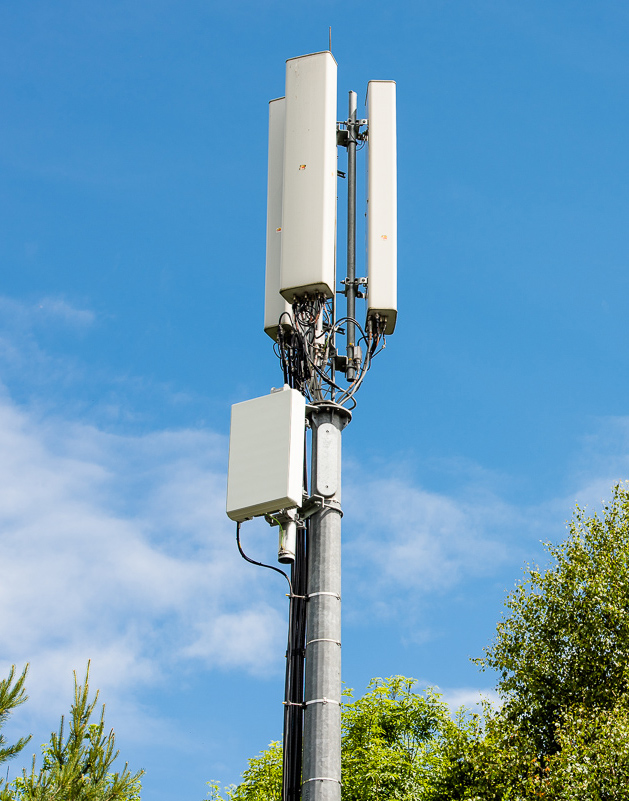2018 was the year when the deployment of Massive MIMO capable base stations began in many countries, such as Russia and USA. Nevertheless, I still see people claiming that Massive MIMO is “too expensive to implement“. In fact, this particular quote is from a review of one of my papers that I received in November 2018. It might have been an accurate (but pessimistic) claim a few years ago, but nowadays it is plainly wrong.

I recently came across a website about telecommunication infrastructure by Peter Clarke. He has gathered photos of Massive MIMO antenna panels that have been deployed by Vodafone and by O2 in the United Kingdom. These deployments are using hardware from Huawei and Nokia, respectively. Their panels have similar form factors and are rather easy to recognize in the pictures since they are almost square-shaped, as compared to conventional rectangular antenna panels. You can see the difference in the image to the right. The technology used in these panels are probably similar to the Ericsson panel that I have previously written about. I hope that as many wireless communication researchers as possible will see these images and understand that Massive MIMO is not too expensive to implement but has in fact already been deployed in commercial networks.

Do you know if this is a “canonical” massive MIMO deployments?
No, I have no reliable information about this. But I would guess that these are 64-antenna panels equipped with rather sophisticated hardware but rudimentary signal processing. Some of the products might use codebook-based beamforming and others might use maximum-ratio-like reciprocity-based beamforming. Hence, these are methods that work well for beamforming to a single user, but are not so good at canceling inter-user interference.
Emil, it is right consideration, if you are talking about FDD frequency bands. IF it is about TDD (i.e. c-band carriers), then it is not totally right, and PHY processing is conventional for M-MIMO, but RRM is simplified, because of complexity in MU-mode. At the picture it seems mmWave 28GHz antenna setup, then totally different story.
Thanks for the input!
Thank you for sharing this. Is there any standard work on the Massive MIMO inside the 3GPP organization? Or is it part of RRM?
If I’m correctly informed, Release 15 supports up to 256 antennas. I suppose codebook-based beamforming is standardized while RRM and reciprocity-based beamforming require much less standardization work.
Since the standard documents from 3GPP are rather hard to read for non-involved people (including myself), I recommend you to read one of the books on 5G New Radio that have recently appeared.
Hi Emil,
Thanks to the transparent downlink precoding paradigm in NR, which in Rel-15 is mainly implemented via precoded UE specific DMRS, the NR standard supports as many antennas as you want.
However if you rely on explicit CSI feedback from the UE (i.e., codebook based [CB] feedback), then there are some constraints. For example, the codebooks only support up to 32 CSI-RS ports. In this context CSI-RS ports are more or less equivalent to 16×2 independent X-pol “virtual” antenna elements.
The max 256 (per CC) you heard about, probably comes from the “totalNumberTxPorts” UE capability constraints for CB based feedback and NZP-CSI-RS.
It is theoretically possible to combine CSI feedback reports up to this number of unique ports. Same goes for requesting more than one CSI-RS resource with up to 32 ports each. However the correct aggregation of the resulting information is not straightforward.
The reciprocity based schemes have less constraints on the massive MIMO side, but there are other complications…
In any case, no one forbids us from combining (e)AAS and (n)CB to form a hybrid precoding-like system, with hundreds of independent antenna elements and limited feedback requirements.
Some companies are/were certainly also going for the “canonical” mMIMO implementation (as it has been called somewhere above). Though, the limited computing resources in the DU seem to be an issue for them.
Hi,
It would be very much appreciated if I could get some information on the following:
“Supplier Roadmaps on MIMO/Massive MIMO and antenna technology and utilisation statistics for a sample country/network”